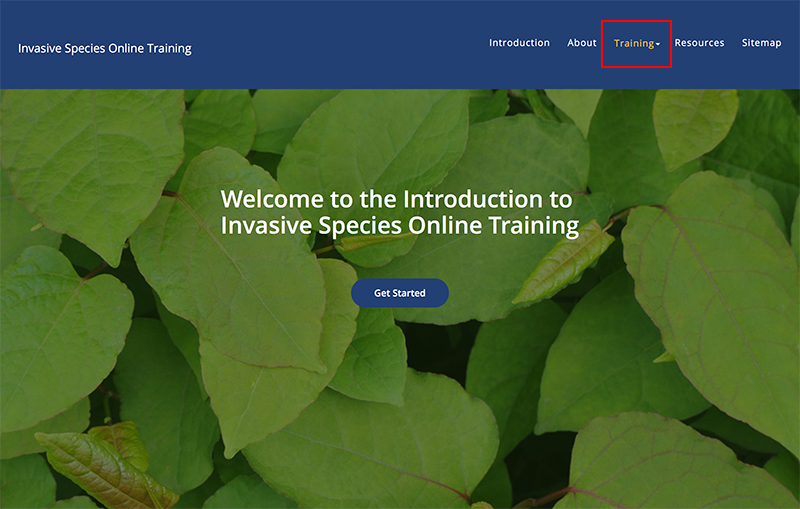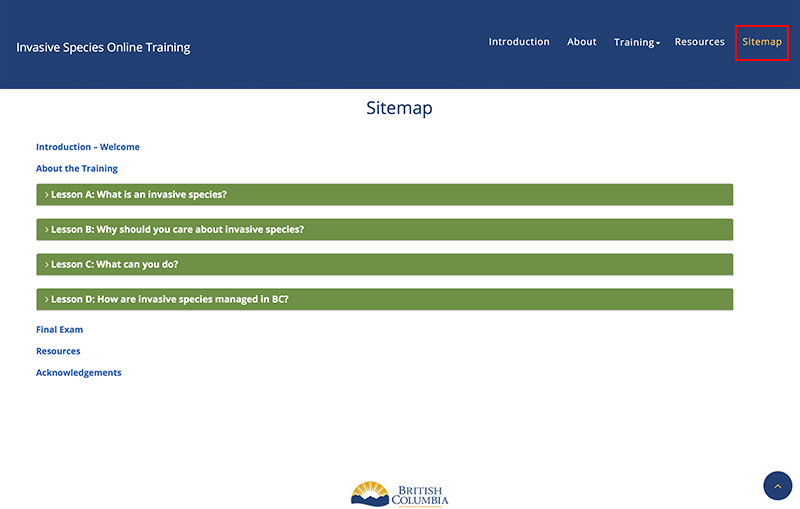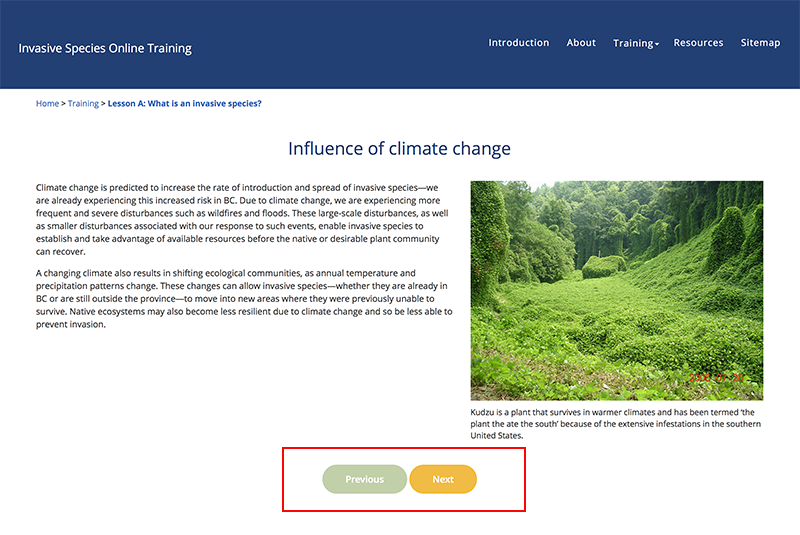Introduction
Welcome to the Introduction to Invasive Species online training course. This course has been developed by the BC Inter-Ministry Invasive Species Working Group (IMISWG). The goal of the course is to increase the awareness and implementation of responsible actions related to invasive species prevention and management by government staff, contractors, and volunteers working on provincial public lands.
Do you know what invasive species are and why we should care about them? Even if you do, this training is a great place to learn about the impacts of invasive species, and what you can do to prevent them. Everyone has a role to play in preventing the introduction and spread of invasive species, including YOU!
By the end of this training, we hope you will:
- understand what invasive species are and how they spread;
- feel inspired to act by understanding the impacts of invasive species;
- implement best management practices to prevent the introduction and spread of invasive species when doing your job, at home, or recreating in BC;
- know how to report invasive species to the Province, and;
- know how to get further information and education on invasive species.
About the Training
What's Inside the Course
The Introduction to Invasive Species online training contains four lessons that should take approximately three to five hours to complete. It includes lesson content, videos, downloadable files, and online activities.
No information related to your course activity will be saved.
There is a final exam at the end of the training and once you have successfully completed the exam, you can add your name to a downloadable certificate of completion for the training.
Your Role
As government staff or as a person working on provincial public lands under an agreement with the Province, this introductory online training will provide you with important information on best management practices that you should take for prevention of the spread of invasive species.
Tips for Navigating
To navigate the course you can explore lessons at any time by using the “Training” tab at the top of the page.

The “Sitemap” tab at the top will help you find a specific page within each lesson.

Within each lesson, you will find “previous” and “next” buttons to sequentially navigate course content.

Note: If you need to stop the training at any time, you may find it useful to bookmark the page you last viewed in your browser to revisit later. The page you were on will otherwise not be saved if you close your browser.
Lesson A: What is an invasive species?
Lesson Objectives:
By the end of this lesson, you will be able to:
- understand the characteristics of invasive species, and
- recognize how invasive species move and spread.
Non-native, exotic, alien, introduced—no matter what you choose to call them, non-native species are plants, animals, and other organisms that are outside their natural range. While some non-native species are desirable and even beneficial, such as garden crops, other non-native species are invasive and cause significant damage to BC’s environment, people, and economy.
So, let’s be clear—what are invasive species? They are plants, animals, and other organisms that are not native to BC, or are found outside areas where they naturally occur, AND that cause negative social, cultural, economic, and environmental impacts. We will be exploring these impacts in detail throughout the course.
In their native environments, these organisms typically have limiting factors such as predators, diseases, and competitors that co-evolved with them, which keep these species in check. When these species are transported to a new environment, these limiting factors are usually left behind, allowing the transported species to spread and dominate with nothing to keep them in check. Invasive species have abilities such as rapid reproduction and tolerance of a wide range of environmental conditions that allow them to outcompete native species for resources such as food, light, and water, enabling them to take areas over.
An invasive plant may also be called a weed, a loosely defined term that typically refers to any plant that is undesirable or growing somewhere it is not wanted. In BC, legislation defines the term “noxious weeds” as the invasive plants specifically listed in the BC Weed Control Act Regulation. More fun and interesting facts about legislation will come later in this training!
Lesson B: Why should you care about invasive species?
Lesson Objectives:
By the end of this lesson, you will be able to:
- understand that invasive species can cause negative economic, social, cultural, and environmental impacts in BC; and
- recognize regulatory frameworks related to the management of invasive species within BC.
BC’s land and water are being affected by invasive species. We are all stewards of our province, and all of us play a role in ensuring that our environment, people, and economy are protected.
Impacts
Invasive species threaten many of our social, cultural, environmental, and economic values. Invasive species cost the global economy billions of dollars every year. They are a top threat to biodiversity, impact culturally and socially important areas, and can threaten human health in various ways, including through stings, burns, or poisonings.
Lesson C: What can you do?
Lesson Objectives:
By the end of this lesson, you will be able to:
- understand how you can prevent the spread of invasive species, and
- recognize and implement best practices related to invasive species management during your daily activities.
Stopping invasive species before they arrive is the best thing we can do. It’s common sense, really—it’s easier to prevent something than fix it after it happens!
Prevention is recognized as the most cost-effective way to manage invasive species worldwide. Once an invasive species arrives to a new area and becomes established, it can be extremely difficult and costly to remove it. Preventing the introduction of invasive species—and reacting quickly should one be detected—is the best approach to avoiding or reducing impacts.
Lesson D: How are invasive species managed in BC?
Lesson Objectives:
By the end of this lesson, you will be able to:
- understand how the Province manages invasive species with Integrated Pest Management (IPM), priority setting, and Early Detection Rapid Response (EDRR); and
- recognize the purposes for using the provincial invasive species data system.
Invasive species do not obey boundaries, so managing them requires coordination across many different organizations. The provincial government works together through the BC Inter-Ministry Invasive Species Working Group (IMISWG) to coordinate and collaborate on the delivery of invasive species programs in BC.
Sitemap
Introduction – Welcome
About the Training
Lesson A: What is an invasive species?
Invaders! Invasive Species in BC
Invasive Rats
Spotted Knapweed
Activity: Native, non-native, and invasive: what’s the difference?
How do invasive species get here and how do they spread?
Using straw at the Vancouver 2010 Winter Olympics: A Story of Accidental Introduction
Influence of climate change
Activity: how can invasive species spread?
Lesson C: What can you do?
Invasion curve
Best management practices (BMPs)
1. Keep clean
Clean drain dry
1.2 Keep clean on land
Play Clean Go
2. Limit disturbance
Restore disturbed areas
Activity: Analyzing certificates of seed analysis - Certificate 1
Activity: Analyzing certificates of seed analysis - Certificate 2
3. Don’t introduce
4. Spot and report
Report Invasives BC App
Activity: Getting to know some priority invasive species
BMP Summary
Activity: Water sampling using best management practices for invasive species
Activity: Installing a culvert using best management practices for invasive species
Lesson D: How are invasive species managed in BC?
Inter-Ministry Invasive Species Working Group (IMISWG)
Key Partners on Invasive Species
Integrated Pest Management
Priority Setting, Containment, and Control
Early Detection Rapid Response
Invasive species data management and access: what you should know
Final Exam
Resources
Acknowledgements